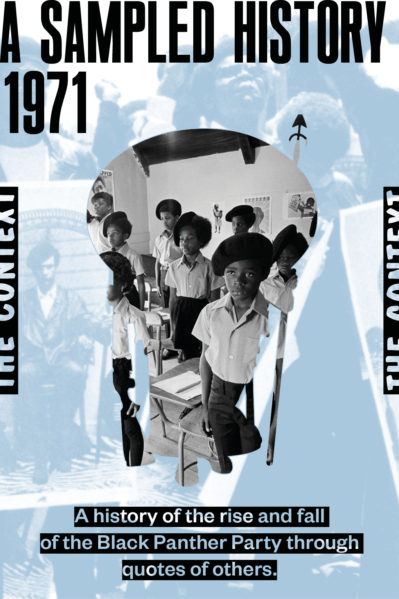A Sampled History 1966/67, 1968, 1969, 1970, 1971, 1972/82.
1971
“In the first two months of 1971, three [NY21, Cleaver, Geronimo] of the most important Panther groups broke with the national organization.” (Bloom 2016, 358)
“From 1971 on, […] a significant number of former members sought to take armed politics to a “higher” level and engage the United States in.” (Bloom 2016, 387)
01.1971 — “Meanwhile, from their refuge in Algeria, members of the International Section of the Party promoted immediate guerilla warfare against the U.S. government. Eldridge Cleaver and Field Marshal Donald Cox regularly exhorted young blacks to violence in the pages of the Black Panther. In January 1971, Cox argued, “When a guerilla unit moves against this oppressive system by executing a pig or by attacking its institutions, by any means — sniping, stabbing, bombing, etc. — in defense against the 400 years of racist brutality, murder, and exploitation, this can only be defined correctly as self-defense.” (Bloom 2016, 358)
01.19.1971 — “On January 19, 1971, the New York Panther 21 published an open letter to the Weather Underground in the East Village Other, not so subtly denouncing their own Black Panther Party national leadership.” (Bloom 2016, 259)
01.23.1971 — “[…] [O]n January 23, […] Huey Newton published a letter in the Black Panther purging from the Black Panther Party Geronimo Pratt.” (Bloom 2016, 360)
02.08.1971 — “[…] [O]n February 8, two of the leading New York Panthers — Dhoruba Bin Wahad (Richard Moore) and Cetawayo Tabor — did not appear for their scheduled court date as part of the New York 21 trial.” […] “The judge ordered a warrant for their arrest. He also revoked the $200,000 bail of Joan Bird and Afeni Shakur, the only two other New York Panthers who were out free on bail, and returned them to prison.” (Bloom 2016, 360)
02.09.1971 — “On February 9, […] the Central Committee expelled most of the New York 21 from the Black Panther Party. […] call[ing] the New York renegades [Dhoruba and Tabor] “enemies of the people.” (Bloom 2016, 361).
02.13.1971 — “The cover of the February 13, 1971, issue of the Black Panther, reproduced the mimeographed statement distributed outside the New York courtroom that expelled most of the New York Panthers from the Party. […] The disappearance of Tabor and Dhoruba had forced the Party to reveal the split.” (Bloom 2016, 362)
02.26.1971 — “On February 26, on the Jim Dunbar “A.M. Show” aired live on San Francisco’s ABC-TV affiliate, tensions in the Party exploded. From the studio, Huey Newton spoke with Eldridge Cleaver in Algiers via telephone. Cleaver demanded that Newton reinstate the New York 21 and that Newton expel Hilliard from the Party. Newton refused to continue the discussion.” (Bloom 2016, 362)
02.26.1071 — “On February 26, 1971, Panther Party leaders Huey Newton and Eldridge Cleaver (still in exile in Algeria) agreed to speak by phone on a local television program broadcast, ostensibly as a show of Party unity. […] Newton and Cleaver expelled each other from the Party. That fatefull phone call was the public acknowledgement of the growing rift between Newton’s notion of a socialist-leaning, politically engaged Panther Party and Cleaver’s notion of a guerilla warfare oriented party.” (Vincent, 2013, 252).
02.28.1971 — “Two days after the televised flare-up, [February 28, 1971] Eldridge Cleaver and Donald Cox released videotapes to the U.S. press accusing Hilliard of turning the Panther organization into atop-heavy and undemocratic bureaucracy that served his personal purposes and of purging those he did not favor.” (Bloom 2016, 363)
03.1971 — “The New York Times reported in March 1971 that the Party was falling apart: “A check of the Party’s chapters across the country suggests that the operation is now only a shell of what it was a year ago.”” (Bloom 2016, 373)
03.06.1971 — “The cover of the March 6, 1971, issue of the Black Panther featured an image of Kathleen Cleaver wearing shades and the headline “Free Kathleen Cleaver and All Political Prisoners.” Inside the issue, an article by Elaine Brown alleged that Eldridge Cleaver was beating Kathleen, preventing her from leaving Algiers, and not allowing her to talk with her fellow members of the Central Committee.” (Bloom 2016, 363)
03.08.1971 — “[…] [O]n Monday March 8, Black Panther Robert Webb was shot in the head and killed […] in New York [Harlem]. In a press conference the following day, Zayd Shakur of the Cleaver-aligned New York Panthers asserted that […] Webb was killed when he attempted to seize copies of the Black Panther that described Kathleen Cleaver as a political prisoner from two Newton allies who were distributing the newspaper on the street.” (Bloom 2016, 363)
03.18.1971 — “The state opened its criminal case against Bobby Seale and Ericka Huggins on March 18 [1971], charging that the Panther leaders were responsible for the murder of Alex Rackley in New Haven.” (Bloom 2016, 372)
03.20.1971 — “Overall, relatively few Black Panther chapters challenged the national Party leadership. […] On March 20, 1971, alongside a notice that the International Section had “defected from the Black Panther Party,” the Black Panther published letters in which crucial national leaders proclaimed their loyalty.” (Bloom 2013, 364) “[…] [F]rom the San Quentin branch of the Black Panther Party, headed by George Jackson, derided Cleaver and declared strong support for Newton. […] The San Quentin branch’s endorsement of Newton did a lot to undermine Cleaver’s credibility.” (Bloom 2013, 364/5)
04.03.1971 — “On April 3, 1971, [the Cleaverite faction] began publishing its own newspaper, Right On!, advocating full and immediate insurrection. The paper was published with support from the Weathermen via an aboveground ally — the Independent Caucus of SDS at the State University of New York. The paper featured articles by Eldridge Cleaver and the New York 21.” (Bloom 2016, 369)
04.17.1971 — “On April 17, 1971, the same day that Kathleen Cleaver’s interview appeared in the Guardian [in which she noted that the International Section had opened a U.S. headquarters in the Bronx and that its main focus would be armed action, sabotage, and support for a military underground] Huey Newton published an essay in the Black Panther titled “On the Defection of Eldridge Cleaver from the Black Panther Party and the Defection of the Black Panther Party from the Black Community.” Newton described the conflict as an ideological one.” (Bloom 2016, 370)
04.17.1971 — “On the afternoon of April 17, 1971, assailants shot [Sam] Napier [national distribution manager for the Black Panther] three times in the back, tied him to a bed in the headquarters of the Oakland-aligned Corona Queens Black Panther chapter, gagged him, shot him three times in the head, and then set the building on fire.” (Bloom 2016, 364)
05.1971 — In May 1971 ‘Soledad Brother’ George Jackson created the San Quentin Chapter of the Black Panther Party with a vision to organize the entire United States black prison population. Jackson was killed on August 1st of that same year in a prison riot.
05.21.1971 — “On May 21 [1971], two New York police officers were ambushed and killed in Harlem. People claiming to be members of the Black Panther – affiliated Black Liberation Army notified the press, taking responsibility for the murders.” (Bloom 2016, 373)
05.25.1971 — On 25th May, 1971, in The New Haven Case, the trial ended in a hung jury and the judge ordered all charges against Seale to be dropped.
06.1971 — “In early June, Dhoruba Bin Wahad and Eddie Jamal Joseph — previously acquitted of all charges in the high-profile New York 21 case —were again arrested and charged with holding up a Bronx social club.” (Bloom 2016, 373)
06.1971 — “In June [1971], the State of California began a retrial of Huey Newton on charges of manslaughter in the 1968 killing of Officer John Frey. That month, the trial of David Hilliard also began for charges stemming from the shoot-out in which Bobby Hutton was killed.” (Bloom 2016, 372)
07.1971 — “In late July [1971], a New York grand jury indicted seven New York Panthers —including Moore and Josephs — in the brutal murder of the national distribution captain of the Black Panther, Samuel Napier.” (Bloom 2016, 373)
08.21.1971 — “On August 21, 1971, guards at San Quentin State Prison in Marin County, California, shot and killed Panther leader, author, and prison activist George Jackson.” […] “Jackson [author of Soledad Brother] founded and led the Black Panther chapter at San Quentin Prison and organized a strong revolutionary movement among prison inmates.” (Bloom 2016, 374)
09.09.1971 — “[O]n September 9 [1971], inmates took over Attica prison in New York. They called in the Panthers to help negotiate their demands but achieved no resolution. On September 13, Governor Rockefeller responded with force, […] to take back the prison. The troops killed twenty-eight prisoners, while nine hostages died in the battle.” (Bloom 2016, 378)
“In late 1971, Newton told David Hilliard that “the Party is over.”” (Bloom 2016, 381)
1970 « » 1972/82
A Sampled History 1966/67, 1968, 1969, 1970, 1971, 1972/82.











